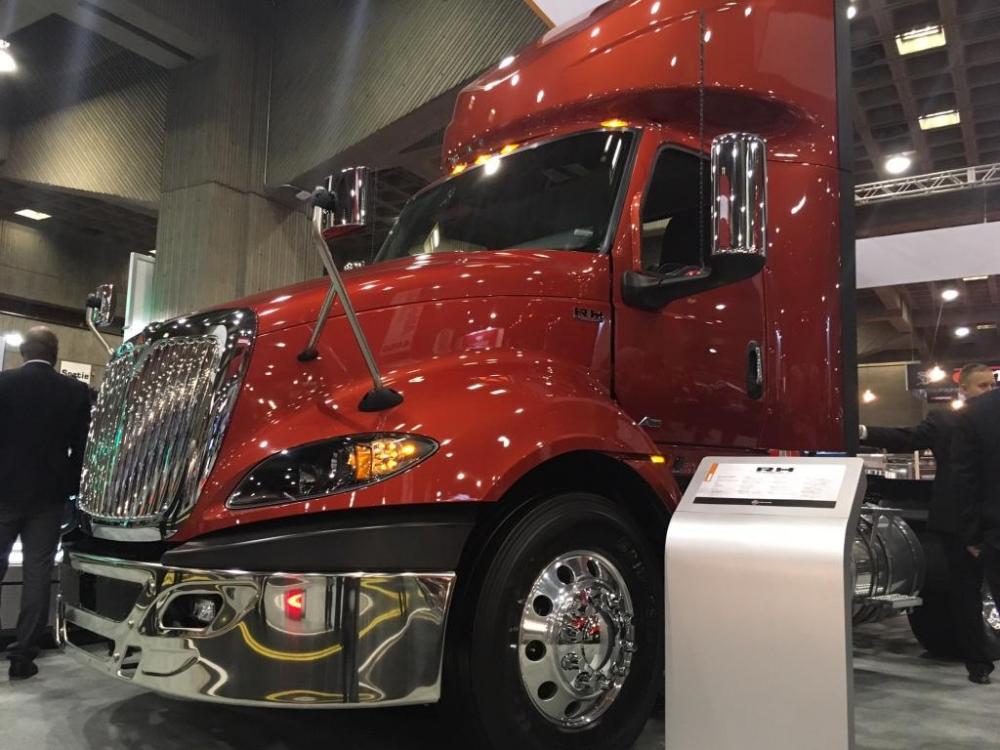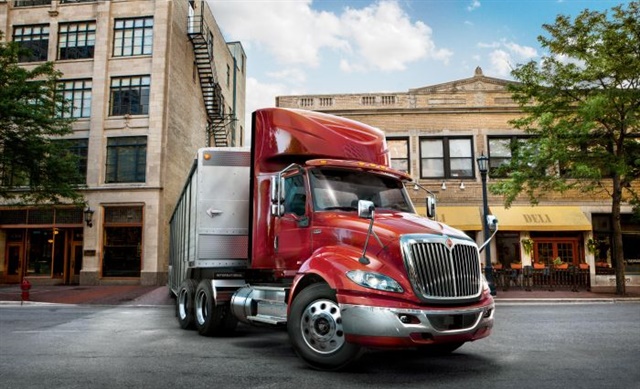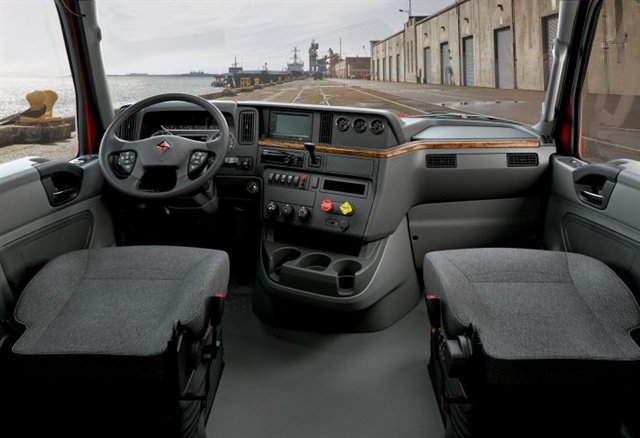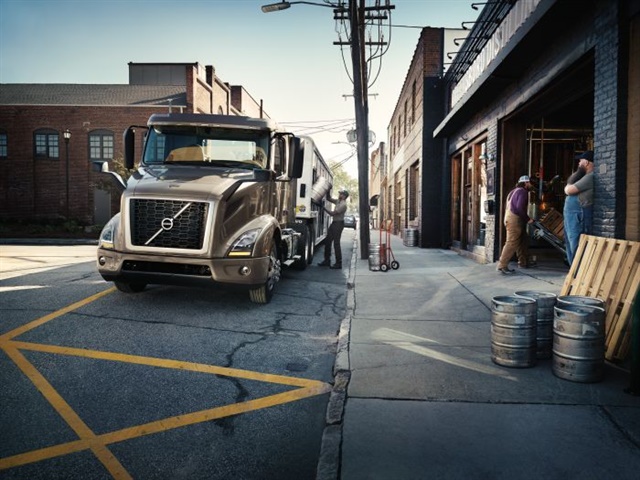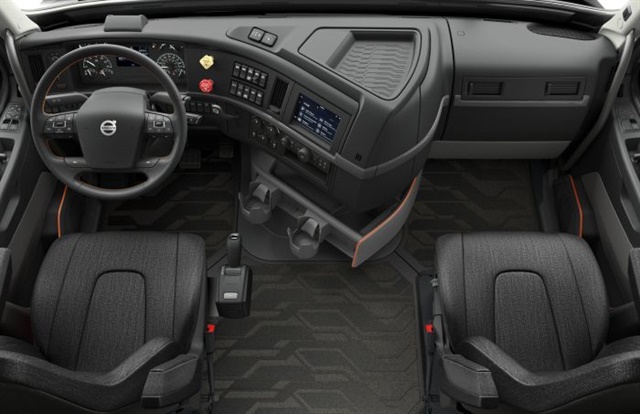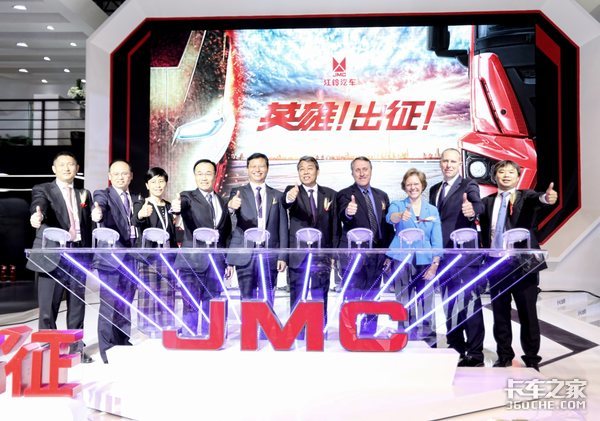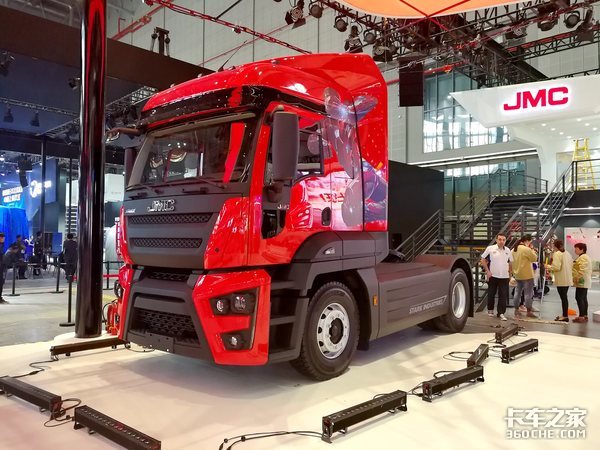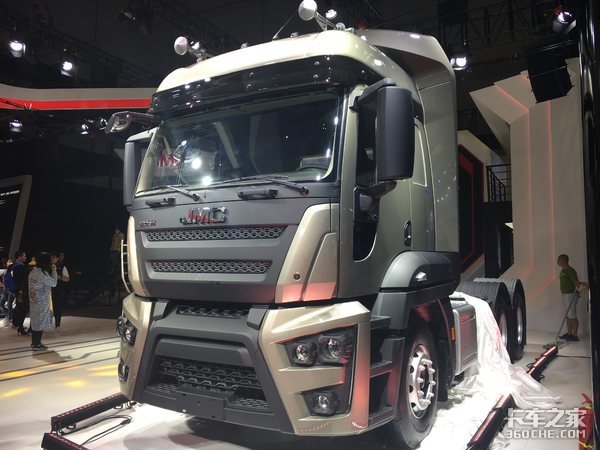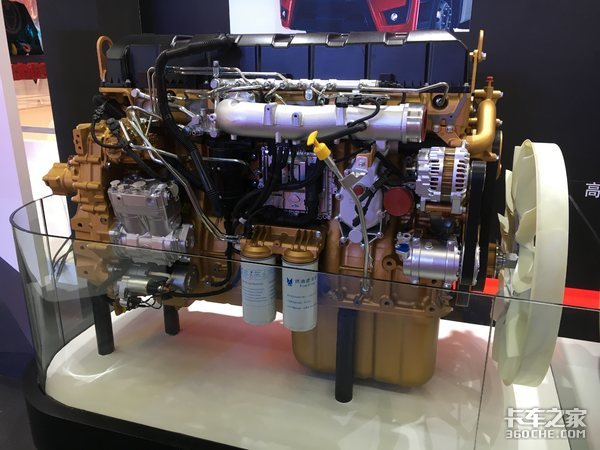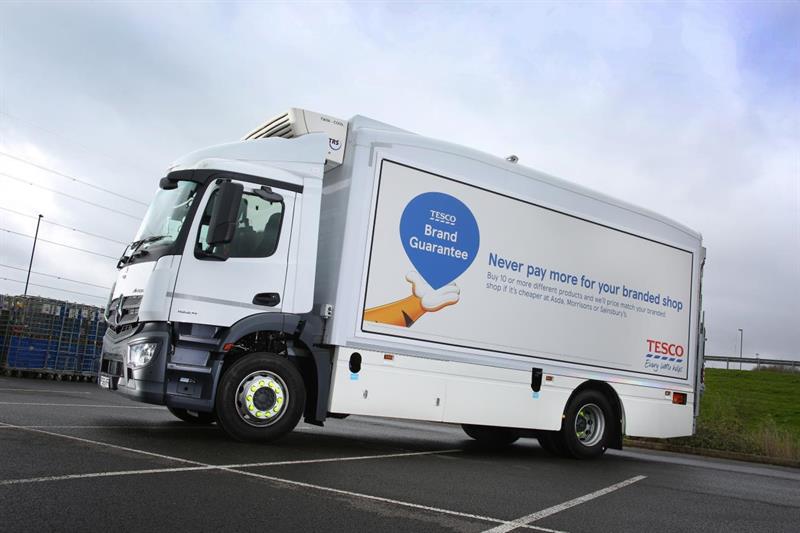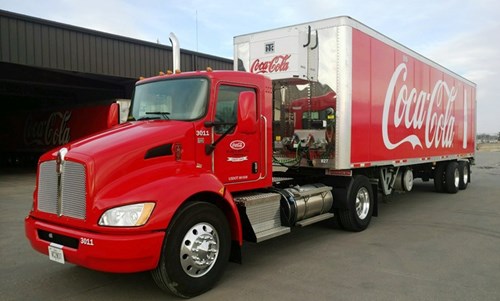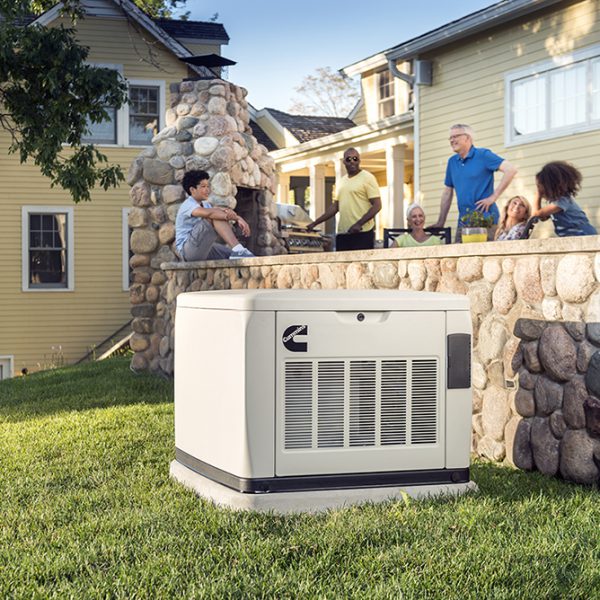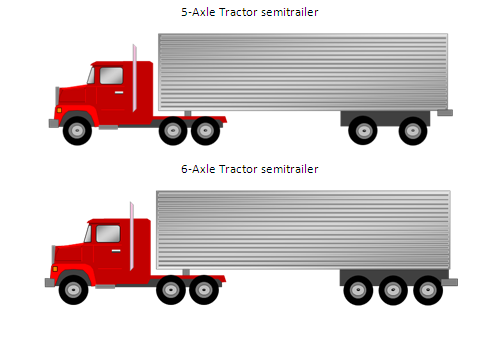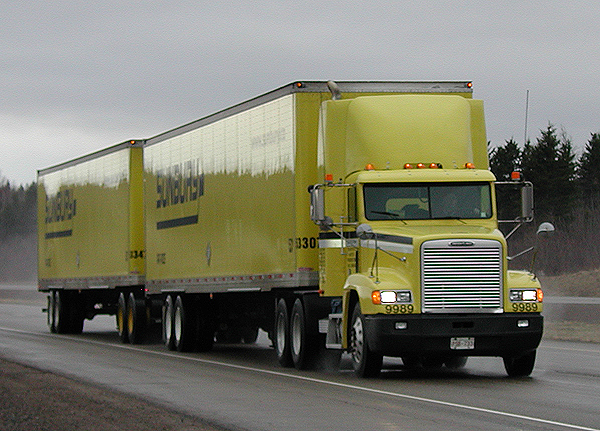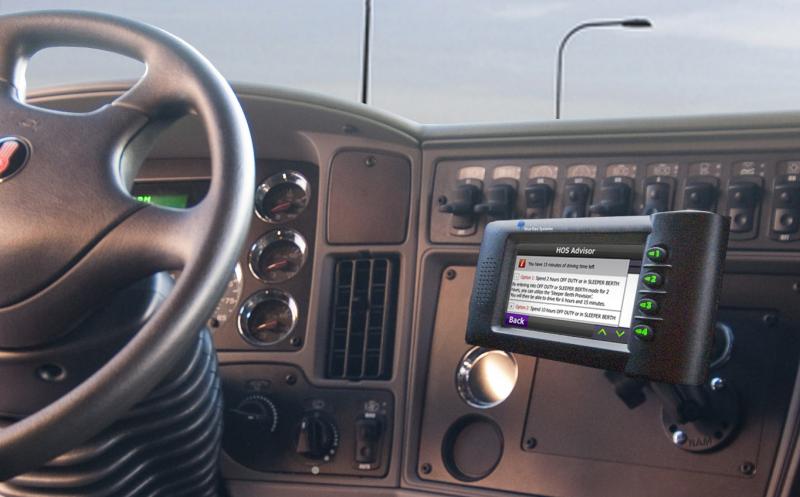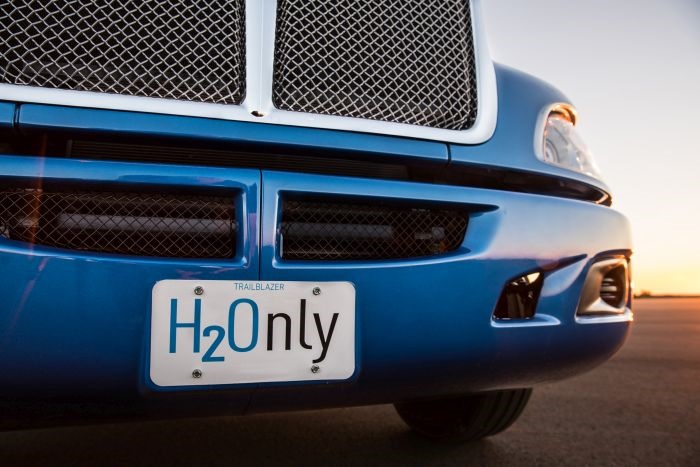
kscarbel2
Moderator-
Posts
18,935 -
Joined
-
Days Won
114
Content Type
Profiles
Forums
Gallery
Events
Blogs
BMT Wiki
Collections
Store
Everything posted by kscarbel2
-
Navistar reveals new Class 8 regional haul tractor
kscarbel2 replied to kscarbel2's topic in Trucking News
International introduces RH Series regional haul truck Truck News / April 20, 2017 MONTREAL, Que. — International Truck today launched its new RH Series regional haul tractor at ExpoCam. The Class 8 tractor is powered by the new International A26 12.4-liter engine. “The new International HR Series continues out commitment to build trucks that lead the industry in uptime,” said Bill Kozek, president, truck and parts, with Navistar. “We are confident this truck will continue to build on our momentum and be successful in the regional haul market.” New features include: cab wiring with all-new harnessing and an in-cab power distribution module that’s inside the truck, away from the elements; ergonomic placement of key service points; and a single canister aftertreatment system that’s 60% smaller and 40% lighter for easier servicing. Drivers will appreciate redesigned side windows and mirrors, which contribute to better visibility. The truck also features a large swept-back windshield and aerodynamic sloped hood for better forward visibility. The truck provides an inside wheel cut of up to 50 degrees and a curb-to-curb turning radius of just 27 feet, 10 inches, the company says. Hundreds of drivers were interviewed when designing the truck. “We drew upon the expertise of drivers to ensure that the RH Series is the most driver-centric Class 8 regional haul vehicle we’ve ever built,” said Denny Mooney, senior vice-president, global product development with Navistar. “Many of our customers tell us that their number one challenge is attracting and retaining drivers, which is why we put so much effort into understanding and responding to drivers’ needs. These improvements also contribute to increased driver ease of use that will boost the vehicle’s productivity.” The RH Series will be offered in configurations including: day cab; 56-inch low-roof sleeper; 56-inch high-rise sleeper; day cab with roof fairing; and 56-inch high-rise sleeper with roof fairing. The company is taking orders now and production will begin in June. . -
. . . . . . . . . . .
-
Mack Now Offers 16,000 Pound Front Axle on Pinnacle
kscarbel2 replied to kscarbel2's topic in Trucking News
Mack’s Proprietary 16,000-pound Front Axle Now Available On Pinnacle Trailer/Body Builders / April 20, 2017 Mack Trucks’ proprietary 16,000-pound front axle is now available for order on the Mack Pinnacle Axle Back and Axle Forward models. Built to bear the heavier loads commonly found in Canada, the 16,000-pound Mack FXL front axle enables carriers to transport more cargo, improving productivity and efficiency. It is also available in the U.S. “Our 16,000-pound front axle improves performance with the same legendary durability and reliability that Mack pioneered,” said Roy Horton, director of product strategy for Mack Trucks. “It’s designed significantly heavier so that our customers can improve their efficiency by transporting more payload at one time.” Mack axles, engineered to work seamlessly with Mack MP engines and Mack transmissions as part of Mack’s integrated powertrain, offer superior strength and improved fuel efficiency. Developed to provide a stable and smooth ride under demanding loads, the Mack FXL axle also simplifies maintenance, improving uptime for customers. -
Heavy Duty Trucking / April 19, 2017 Mack Trucks’ 16,000-pound front axle is now available for order on the Mack Pinnacle Axle Back and Axle Forward models. Available in the U.S. and Canada, the 16,000-pound Mack FXL front axle is built to bear heavier loads to allow carriers to haul more cargo, improving productivity and efficiency. “Our 16,000-pound front axle improves performance with the same legendary durability and reliability that Mack pioneered,” said Roy Horton, director of product strategy for Mack Trucks. “It’s designed significantly heavier so that our customers can improve their efficiency by transporting more payload at one time.” Mack axles are engineered to work with Mack MP engines and Mack transmissions as part of the company’s integrated powertrain, offering improved strength and fuel efficiency. The Mack FXL was developed to provide a stable and smooth ride under demanding loads and also simplify maintenance to improve uptime.
-
Navistar reveals new Class 8 regional haul tractor
kscarbel2 replied to kscarbel2's topic in Trucking News
International Reveals RH Regional Tractor; Designed with Driver Input Heavy Duty Trucking / April 20, 2017 MONTREAL -- International Trucks rolled out its RH Series, a new Class 8 regional-haul tractor here on April 20 at the ExpoCam truck show. The OEM said the RH was designed with driver input to help improve uptime, visibility, and fuel economy over similarly equipped models. RH Series trucks will be powered by the International A26 12.4L engine and will feature design improvements aimed at improving uptime, including reliability and serviceability enhancements. These features include: Cab wiring with all-new harnessing and an in-cab power distribution module that is inside the truck, away from the elements. All key service points under the hood, inside the cab, and around the vehicle are ergonomically designed for easy access and servicing, and many components have been engineered with longer intervals between required maintenance. The new single-canister aftertreatment system is not just 60% smaller and 40% lighter, but is also simplified for quicker servicing "The new International RH Series continues our commitment to build trucks that lead the industry in uptime," said Bill Kozek, president, truck and parts, Navistar. "We are confident this truck will continue to build on our momentum and be successful in the regional haul market." The A26 engine is built from the MAN D26 engine crankcase and it produces up to 450 horsepower and 1,750 lb.-ft. of torque from a design that's 600-700 pounds lighter than a traditional 15L big bore engine, according to International. The engine's components have been engineered to deliver improved uptime and fuel efficiency, reduced weight, and quiet operation. International said the A26 is well suited for beverage, bulk haul, and other regional-haul applications. The RH was also designed with driver visibility in mind with new windows and mirrors to improve side visibility. The interior is designed around how a driver will interact with the truck from the inside. Features like a large swept-back windshield, optimized mirror placement, and an aerodynamic sloped hood for a clearer view, were aimed at improving visibility in the RH. The interior also features a premium gauge cluster with a digital driver display that places everything within reach of a driver, while offering real-time monitoring of fuel economy and other important alerts. The new display also offers up to 15 customizable digital gauges. Additionally, the air horn was relocated back to its "traditional, intuitive position" over the driver door in response to overwhelming driver feedback. Maneuverability was also improved in the RH. An inside wheel cut of up to 50 degrees provides a curb-to-curb turning radius of 27 feet, 10 inches to help drivers navigate city streets. “We drew upon the expertise of drivers to ensure that the RH Series is the most driver-centric Class 8 regional haul vehicle we've ever built," said Denny Mooney, senior vice president, global product development, Navistar. "Many of our customers tell us that their number-one challenge is attracting and retaining drivers, which is why we put so much effort into understanding and responding to drivers' needs. These improvements also contribute to increased driver ease of use that will boost the vehicle's productivity." Aerodynamic improvements in the RH Series have decreased wind noise to improve driver comfort in the cab while also yielding up to a 6% improvement in fuel efficiency, according to International. In addition, weight reduction was achieved by leveraging such technologies as a single- canister aftertreatment device, the International Ride Optimized Suspension, and aluminum fuel tank hangers, as well as the lighter A26 engine. From a safety standpoint, the Bendix Wingman Advanced Collision Mitigation system comes standard in the RH Series – an industry first in the regional haul market, according to International. The RH Series will be offered in multiple configurations, including day cab, 56-inch low roof sleeper, 56-inch hi-rise sleeper, day cab with roof fairing, and 56-inch hi-rise sleeper with roof fairing. . -
Fleet Owner / April 20, 2017 International RH Series to be mated with OEM’s new 12.4-liter A26 engine. Navistar is introducing a new regional haul Class 8 tractor this week: the International RH Series, which will be spec’d with the OEM’s new 12.4-liter A26 engine – unveiled back in March – as its standard power plant. "The new International RH Series continues our commitment to build trucks that lead the industry in uptime," said Bill Kozek, president of truck and parts for Navistar, in a statement. "We are confident this truck will continue to build on our momentum and be successful in the regional haul market.” He added that Navistar is now taking orders for this new truck, with plans to begin production in early June. New features on the RH Series include: Multiple cab configurations, including day cab, 56-in. low roof sleeper, 56-in. hi-rise sleeper, day cab with roof fairing, and 56-in. hi-rise sleeper with roof fairing. The Bendix Wingman Advanced Collision Mitigation system as standard equipment. An inside wheel cut of up to 50 degrees delivering a curb-to-curb turning radius of just 27-ft. 10-in. for better maneuverability in tight city streets or cramped loading docks. Aerodynamic improvements, reduced weight, and driveline enhancements make the RH Series up to 6% more fuel-efficient versus previous regional haul models. Those aerodynamic improvements also yielded a four-Sone decrease in wind noise for improved driver comfort. Ergonomically designed service points under the hood and around the chassis for easier and safer access, with many components engineered with longer intervals between required maintenance. Cab wiring with all-new harnesses connected to an in-cab power distribution module that is located inside the truck for more protection from the elements. A new dashboard display that offers up to 15 customizable digital gauges, with the air horn relocated back to its traditional “intuitive” position over the driver door. A new single-canister after-treatment system that is 60% smaller, 40% lighter, and simplified for quicker servicing. Navistar added that drivers will benefit from the redesigned side windows and mirrors on the RH Series, which provide enhanced side visibility. The OEM also noted that it developed the interior of the RH Series based a study of interaction points between the driver and truck – everything from what a driver sees to how he moves and reacts in virtually any situation. That resulted in design features such as a large swept-back windshield, more optimized mirror placement, plus an aerodynamic sloped hood for a clearer view. "We drew upon the expertise of drivers to ensure that the RH Series is the most driver-centric Class 8 regional haul vehicle we've ever built," explained Denny Mooney, senior vice president for global product development at Navistar, in a statement. "Many of our customers tell us that their number-one challenge is attracting and retaining drivers, which is why we put so much effort into understanding and responding to drivers' needs,” he pointed out. “These improvements also contribute to increased driver ease of use that will boost the vehicle's productivity." International RH website - https://www.internationaltrucks.com/trucks/rh-series
-
Volvo Details 'Versatile' New VNR Regional Tractor Heavy Duty Trucking / April 20, 2017 MONTREAL -- After unveiling its new VNR regional tractor, Volvo Trucks provided more details at the Expo Cam trucking trade show ihere on April 20. Designed to be a versatile regional-haul tractor, the new model features refinements and innovations in aerodynamic design, working environment, engine and transmission options, gearing and loading efficiencies, passive and active safety systems, and integrated connectivity. T Volco describd the VNR as made to be driven in urban areas for P&D, liquid tanker, dry bulk, flatbed, and other regional-haul applications. “Our goal with the new VNR was to give our customers a versatile tool to meet their individual needs and challenges in the critical regional-haul market,” said Göran Nyberg, president of Volvo Trucks North America. “Our investment in this new truck is a clear signal of Volvo’s commitment to meeting the needs of regional-haul customers in North America today and in the future.” As detailed at the unveiling, maneuverability and versatility in tight spaces was a focus in designing the new truck. With a 113-inch bumper to back of cab length, improved sightlines over the hood, and a 50-degree wheel cut, the truck can more easily navigate urban streets. Aerodynamics were also a point of emphasis, aimd at improving fuel economy when on the open road. “The VNR model is a work truck, but it’s a dynamic, premium work truck, and aerodynamics are greatly important within the regional haul segment,” said Wade Long, director of product marketing for Volvo Trucks North America. “Regional routes often mean traveling at highway speeds, where aerodynamics becomes increasingly important. With the new VNR model, customers will see an overall fuel efficiency gain of up to 3.5% compared with our previous regional haul model.” The driver’s experience in the cab was also of high importance, and the company’s chief designer said Volvo filtered every innovation “through the driver’s eyes.” This design philosophy found its way into the truck through features like a three-motion steering wheel, new seats with more adjustments to fit driver preferences, and various amenities. Other driver-facing options include an infotainment system with Apple CarPlay, offering high-end audio with WiFi, Bluetooth, navigation, apps, and an exterior camera. A new gauge cluster is larger with a color driver information display in the dash operated by wheel-mounted controls with access to trip information, performance data, and vehicle diagnostics. Noting its power and efficiency, Volvo said it is offering the D11 as the VNR’s standard engine, rated for up to 425 horsepower. Available optionally is the Volvo D13 with up to 500 horsepower. Both engines feature wave pistons, a proprietary Volvo design that burns fuel more efficiently and a common rail fuel delivery system designed to be lighter, quieter and more precise. The engines were also designed to be easier to service with shimless rockers and quicker access to the exhaust aftertreatment system. Each engine can be combined with an XE eXceptional Efficiency transmission package to make the VNR more efficient through downspeeding. Paired with a Volvo I-Shift automated manual transmission as standard equipment allows the spec’ing of automated functions like Adaptive Loading to lift an axle when empty for more efficiency and Adaptive Gearing, which locks out overdrive when fully loaded. The new Volvo VNR also offers passive and active safety technologies. Volvo Active Driver Assist warns drivers through sound and a critical warning signal projected onto the windshield when they approach too close to an object in front of them, and the system can automatically apply brakes to help mitigate a collision. LED headlights increase visibility and decrease light spillover onto oncoming traffic, making the road safer for everyone. Automotive features, like automatic lighting and rain-sensing wipers, provide convenience and help driver safety, while the lane change support system provides visibility to blind spots. The VNR features Volvo’s high-strength steel cab and exceeds both the Volvo Swedish Cab Safety Test and ECE R-29 rollover requirements. In the event of a crash, available side airbags for the driver’s seat also help protect the driver in a rollover. The driver’s seat airbag complements the steering wheel-mounted driver's side airbag, which is standard on the VNR. Lastly, the VNR comes standard with Volvo Uptime Services along with the OEM's telematics hardware, providing connectivity for predictive diagnostics and monitoring of critical engine, transmission and aftertreatment trouble codes through Volvo’s Remote Diagnostics. Customers can also perform powertrain software and parameter updates through Remote Programming, which was announced earlier this year. Volvo said its around-the-clock support through Volvo Action Service can monitor critical vehicle codes and assess the severity of a fault code. VAS agents can take this information and contact a vehicle owner to decide whether to keep operating a truck or take it in for service. The entire process is documented and tracked through Volvo’s ASIST online service management and communication platform to give better visibility into case status, repair scheduling, and parts and service bay availability. VAS agents also facilitate Remote Programming updates. .
-
Volvo unveils new regional haul tractor Jim Mele, Fleet Owner / April 20, 2017 VNR combines aerodynamics, maneuverabilty, advanced safety and driver comfort MONTREAL. Echoing aerodynamic styling cues from its long-haul VNL Series, Volvo Trucks North America (VTNA) has introduced a new regional tractor. The VNR Series features new interior and exterior designs intended to improve productivity, fuel efficiency, driver comfort and uptime, positioning it for an expected growth in regional hauling applications, according to Goran Nyberg, VTNA president. Last year regional tractors accounted for 28% of U.S. Class 8 sales and day cabs roughly 40% of total tractor sales, according to figures provided by VTNA. Factors such as the growth of containerized traffic to East Coast ports with the new Panama Canal and a driver shortage pushing fleets to shorter routes and slip-seat operations that get drivers home at night should lead to continued growth in that segment, Nyberg said. While there will always be a need for long-haul tractors, Wade Long, VTNA's dirctor of product marketing, said those shifting factors could reverse the 60/40 sleeper/day-cab split within the next five years. The new VNR300 day cab model retains the 113-in BBC length of the Volvo VNM model it is replacing, allowing it to meet various regional overall length restrictions and maintaining maneuverability in tight P&D and urban environments. It will also be offered in two sleeper versions – the VNR400 with a 42-in flat-roof sleeper and the VNR640 with a 61-in mid-roof sleeper. The VNR’s standard engine will be the Volvo D11 with ratings up to 425 hp/1,550 lbs.-ft. torque, and the D13 will also be available for applications that require up to 500 hp and 1,850 lbs.-ft. torque. Both will be matched with the company’s newest generation of the I-Shift 12-spd. automated mechanical transmission, and will be available with 4x2, 6x4 and Volvo’s 6x2 adaptive loading rear axles. The VNR exterior “brings aerodynamics to a segment that does not typically get them,” Long said at a press conference introducing the new truck. The deeply sloped hood also adds improved forward visibility, while a three-piece bumper wraps in tightly to augment a 50-degree wheel cut for maneuverability. Additionally, flush-mounted integrated LED headlamps are placed on top of the fenders to reduce accidental damage in tight quarters. The combination of aerodynamics and new Volvo powertrain improvements will deliver up to a 3.5% fuel efficiency gain over the VNM, according to Long. Inside, the VNR has a completely new interior designed to accommodate a wider variety of drivers as well as ease the frequent exits and entries of local hauling. Highlights include a new steering wheel that not only tilts and telescopes, but can be adjusted by 30-degrees for head tilt and houses up to 19 control buttons. The dash features a 5-in. high-resolution driver information display that can be customized by a driver for relevant alerts and feedback. A separate touchscreen infotainment replaces the radio adding Car Play iOS and Android functions as well as navigation screens and rear view camera display. The VNR will be offered in three interior trim levels and with seven seat options that include integrated heat and ventilation. The driver’s seat also features a quick air-release function making it easier for a driver to exit the cab and then return the seat to full pressure. A modular dash rail system can be easily adapted to replace cup holders with a variety of device docks, and there are as many as 12 USB and 12V power connections available. Like Volvo’s line-haul tractor, the VNR can be optioned with a variety of active safety systems, including its Active Driver Assist adaptive cruise control with automatic emergency braking, lane departure warning, and automatic headlights and rain-sensing windshield wipers. VTNA will begin taking orders for the new VNR on May 1, with production scheduled to start in August. The current VNM regional tractor will be phased out of production by the end of the year. Introducing the VNR to customers at an event during the ExpoCam truck show here, Nyberg acknowledged the forces slowly shifting more freight to regional hauling. “The climate [for trucking] is for sure changing,” he said as they unveiled the truck. “We’re here to help you navigate that change with the Volvo VNR, a completely new and re-imagined regional haul tractor.” Photo gallery - http://fleetowner.com/equipment/volvo-trucks-shows-new-vnr-lineup
-
Volvo Unveils VNR Regional Tractor Jim Park, Heavy Duty Trucking / April 19, 2017 MONTREAL -- Volvo Truck North America has just added a new regional tractor to its stable. The unveiling took place here Wednesday on the eve of Canada's largest trucking trade show, ExpoCam. We haven't learned a lot about the truck yet, as the official press conference takes place Thursday morning. Volvo has said it expects the regional and short-haul segments will be areas of growth in the near future, and the VNR is poised to be the truck of choice for that application. "We have been listening to food retailers and petro-chemical producers, and this is the truck they tell us they have been looking for," said VTNA president Goran Nyberg. Goran said the industry is shifting toward a hub-and-spoke or a relay-type of operation to attract drivers. "Many drivers are leaving the industry because they aren't happy being away for weeks at a time," said Nyberg. "Relays and hub-and-spoke will get drivers home regularly and more often, and many fleets are already tailoring there operations that way to attract the best drivers." Volvo's VNR at a Glance The VNR will be available in three configurations: -VNR 300 basic daycab local service, -VNR 400 42-in. flat-roof sleeper for regional overnight trips -VNR 640 61-in. mid-roof sleeper for regional multi-day trips Design changes to the cab and hood, shorter 113" BBC, better wall-to-wall turning radius, better visibility fore and sides Three interior trim levels: Fleet, Express and Premier Volvo D11 engine is standard, 325-425 hp / 1,250-1,550 lb-ft Volvo D13 engine is optional, 375-500 hp / 1,450-1,850 lb-ft Transmissions: Volvo I-Shift, Eaton-Fuller 10, 13, 18 or Allison 5-6 speed automatic The VNR will be available with most of the fuel saving, safety and maintenance features available in the current lineup, such as a downsped drivelines, remote diagnostics and more. It's not markedly different in appearance, but it has a 113-in. BBC and a more rounded hood and front bumper. There's some styling clearly reminiscent of Volvo's SuperTruck. We'll have more details on the new VNR after the press conference here on Thursday morning. Photos of the launch event here.
-
China market Ford Cargo heavy tractor arrives
kscarbel2 replied to kscarbel2's topic in Trucking News
Yes, Bob. Both Ford Otosan and Ford corporate. -
China market Ford Cargo heavy tractor arrives
kscarbel2 replied to kscarbel2's topic in Trucking News
360 Truck / April 19, 2017 The Ford Cargo-based JMV heavy truck made its market debut at the 17th Shanghai international auto show on April 17. The China market Ford Cargo, wearing the JMC badge, utilizes Ford heavy truck technology including its engine, cab and chassis. The truck is positioned opposite the market’s leading heavy truck competition. The China market Ford Cargo utilizes locally produced FUWA lightweight drive axles. FUWA has received Ford's Q1 quality certification. . -
Associated Press / April 19, 2017 Oshkosh Corp. has secured $258 million in orders to rebuild trucks and manufacture trailers for the Army. Oshkosh will rebuild 670 heavy tactical vehicles. The Army says it saves about 25 percent when a truck is rebuilt rather than completely replaced. It refurbishes trucks with bullet holes, bent frames and mangled wheels to become like-new vehicles. Oshkosh will also produce 356 vehicle trailers in the latest round of Army orders.
-
Tesco front of the queue to trial new refrigeration system
kscarbel2 posted a topic in Trucking News
Transport Engineer / April 19, 2017 Tesco is trialing Carrier Transicold multi-temperature refrigeration units, which run on hydro-electric power generated by the truck’s Euro 6 engine. The units have been fitted to two Mercedes-Benz Antos rigids and are the first trucks with alternative refrigeration technology to join Tesco’s fleet. “We are delighted to be one of the first customers trialling this new type of engineless refrigeration unit offering significant environmental benefits,” says Caroline Sindrey, engineering manager for Tesco. “The new system offers huge potential to help us reduce our carbon footprint through lower emissions and diesel consumption, as well as decreasing air and noise pollution. We also hope it will reduce maintenance and fuel costs across our fleet of vehicles in the long term.” The systems are driven by an Eco-Drive GenSet power unit, which is powered by a hydraulic pump connected to the truck’s engine power take-off. The hydraulic pump drives a generator that delivers electrical power to the refrigeration unit and provides a continual refrigeration capacity even at the truck’s standard idle speed. With a PIEK-compliant noise level rating as standard, the units are suited to urban deliveries. With two refrigerating circuits fed by separate fully-hermetic scroll compressors, items such as drive belts, pulleys and compressor shaft seals are eliminated, which in turn optimises uptime and refrigerant containment. This configuration – coupled to two economisers and a wide surface condenser – means the system provides a cooling capacity of up to 18,400W. . -
Scania Group Press Release / April 19, 2017 It took 5 years of testing, often on open roads, before the next generation was launched. Still, we managed to keep it under wraps. .
-
DAF Trucks / April 19, 2017 Every journey should start efficiently. #DAFreveals . . . . . .
-
Kenworth Truck Co. / April 19, 2017 ATLANTIC, Iowa, April 19, 2017 - Atlantic Coca-Cola Bottling Company, has been in the Tyler family for more than 100 years. Beginning as an ice cream company in 1905, the company soon expanded into soft drinks named “Tyler’s Flavors.” That changed in 1929 when Atlantic acquired franchise rights to bottle and distribute Coca-Cola. The company has been growing ever since. Growth over the past three years has been unusually rapid as the company expanded from two locations to nine, and from 200 to 700 employees. Overseeing Atlantic’s growth is owner and chairman Jim Tyler. His son, Kirk Tyler, is CEO and company president. Rob Feeney runs day-to-day operations, along with Ned Brown, senior vice president of operations Brian Harris is fleet maintenance manager. Atlantic’s service area now covers most of Iowa and extends into a few neighboring states. The 120-truck fleet includes a growing roster of Kenworths, featuring T370 route trucks powered by PACCAR PX-9 [Cummins ISL 8.9L] engines and Allison 6-speed automatic transmissions. Atlantic route trucks often run 10-plus years before trade-in, so long term durability is critical. “The durability factor was evident to us from the beginning,” said Brian Harris, fleet maintenance manager. “With our very first T370, as we were putting the box on it, right away we noticed the frame is built much sturdier than other brands of trucks we’ve owned. Right there, we determined to get more Kenworths. It’s a heavier built truck.” Since purchasing its first T370, Atlantic has ordered several new T370s every year over the past five or six years, including 12 new T370s in 2016. “The Kenworth T370 is simply a better route truck,” said Brown. “We think it is important to have equipment that’s exceptional. Image matters. We produce a premium product and want premium trucks to deliver it. Kenworth trucks do a much better job of drawing attention to quality. It’s a moving billboard that speaks well for our company.” Atlantic’s T370 straight trucks haul up to one thousand cases of Coca-Cola products, or 12 pallets. Some T370 tractors haul 35-foot trailers that carry 20 pallets. Drivers make 12 to 20 stops, jumping in and out of the cab all day long. “Our drivers tell us the Kenworth cab is comfortable and better built than other trucks,” said Harris. “The T370 is quieter going down the road, the doors shut tight and the interior is nicer all around.” The company works with MHC Kenworth – Des Moines for sales and service. With rapid growth, said Brown, “it’s nice to have our Kenworth dealer to rely on. MHC Kenworth has been instrumental in helping us spec the delivery truck we need. For example, we’ve done some things on the truck to improve efficiency. Some of our locations in the new territory require our route trucks to travel farther distances. We wanted a bigger fuel tank, and we wanted to move it to the driver side. The dealer helped us reconfigure all that. “The T370s help sell our product,” Brown concludes. “When you’re driving down the road and see a great-looking truck, you make a connection with the product, and you want to buy that product. Our fleet has to look good. We haven’t had any problems with our Kenworth trucks. There really is no comparison between Kenworth and other trucks.” .
-
Ideas for Using Your Tax Refund for Your Home Leah Ingram, Cummins Press Release / April 19, 2017 Invest in a standby generator We live in a beach town in New Jersey that was one of the hardest hit during 2012’s Superstorm Sandy. It’s no surprise that nearly every house in our neighborhood has a standby generator. These are the generators that run on natural gas or propane. Unlike portable generators that can be noisy and require manual set-up, running cords and gasoline, standby generators cycle on automatically as soon as the power goes off. Once you’ve lost power for an extended period of time and suffered the inconveniences that come with being powerless, you quickly realize the importance of a standby generator. Cummins has an online quiz you can take to evaluate your home generator needs. This Cummins quiz helps you determine how much power your home needs to keep running when the power is out and can help you select the right standby generator for you. Take the quiz now at https://homegenerators.cummins.com/ Another reason to use your tax refund to invest in a standby generator–hurricane season is just around the corner. Hurricane Season is officially May 1 through December 1, butyou never know when during the season you could get hit. Remember: Superstorm Sandy happened days before Halloween–and days before the hurricane season would have been officially over. Realtors tell me that when it comes to selling a home in hurricane-prone states, a standby generator can make your home stand out from others. This makes them more attractive to buyers who are looking for this premium amenity and, dare I say, necessity in a place where power outages come with the weather. .
-
The Electronic Logging Device (ELD) Controversy
kscarbel2 replied to kscarbel2's topic in Trucking News
Texas to require intrastate drivers to use ELDs by 2019, other states to follow James Jaillet, Overdrive / April 19, 2017 Texas has updated its hours of service code to require intrastate truckers to use electronic logging devices to record duty status. Truck operators in the state must begin using the devices by Dec. 19, 2019. The effective date of the federal government’s mandate requiring ELDs for interstate truckers is Dec. 18, 2017. Texas’ new regs are sparse on detail, simply pointing to the U.S. DOT code requiring ELDs and establishing an effective date. The minimum device spec’s will be the same as the federal government’s mandate, but it’s unclear whether the exemptions to the federal mandate will apply to intrastate operators. Overdrive has reached out to the Texas Department of Public Safety regarding possible exemptions and will report on the information will it becomes available. The state specifies an exemption for truckers hauling agricultural products within a 150-air-mile radius of a commodities’ point of origination or distribution during harvest season. Though Texas appears to be the first state to issue an ELD requirement for intrastate truckers, other states will likely soon follow, says Joe Rajkovacz, head of regulatory affairs for the Western States Trucking Association. Federal regulations require states to adopt laws for intrastate truckers compatible with national laws. Most states will fall in line without fanfare, he says, but there could be a few standouts, he said, at least initially. Which states may try to rebut the U.S. DOT on adopting an ELD requirement for intrastate truckers isn’t clear, he says, but there’s already some drama playing out on the issue in his home state, California. “It remains to be seen if this state falls in line,” he says. Rajkovacz says looser intrastate laws on hours of service — 12 hours of daily driving time — has the state’s regulators wondering if the cost of the mandate for intrastate operators will yield a safety benefit. “In the end,” he says, federal laws requiring state compliance “will probably win the day.” -
Toyota Explores Heavy Truck Hydrogen Fuel Cell Application
kscarbel2 replied to kscarbel2's topic in Trucking News
Toyota unveils fuel-cell Class 8 tractor prototype Fleet Owner / April 19, 2017 Dubbed “Project Portal” its runs on electricity generated by a hydrogen-powered fuel cell. Toyota Motor North America (TMNA) officially took the wraps off its “Project Portal” prototype Class 8 tractor this week – a hydrogen fuel cell system designed for heavy duty trucks operating at the Port of Los Angeles. The OEM said this “proof of concept” zero-emission truck is fully functioning, with the power and torque capacity to conduct port drayage operations while emitting nothing but water vapor. It will be part of a feasibility study that begins this summer which will examine the potential of fuel cell technology in heavy duty applications “By bringing this heavy duty, zero emission hydrogen fuel cell proof of concept truck to the Port, Toyota has planted a flag that we hope many others will follow,” said Mary Nichols, chair of the California Air Resources Board (CARB), in a statement. “CARB will be following the progress of this feasibility study with interest, as we look to develop the best mix of regulations and incentives to rapidly expand the market for the cleanest, most efficient big trucks to meet the need for dramatic change in the freight sector,” she added. “Hydrogen fuel cell vehicles play a role in California’s efforts to achieve greenhouse gas emission reduction goals, improve air quality, and reduce our reliance on fossil fuels,” added Janea Scott with the California Energy Commission (CEC), which is why the CEC making invests in the refueling infrastructure needed to support adoption of these vehicles, Scott noted. The Project Portal tractor generates more than 670 hp and 1,325 lb.-ft. of torque from two Mirai fuel cell stacks and a 12 kilowatt-per-hour (kWh) battery – a relatively small battery to support Class 8-type loads, Toyota noted. The concept’s gross combined weight capacity is 80,000 lbs., and its estimated driving range is more than 200 miles per fill, under normal drayage operation, noted Bob Carter, executive vice president with TMNA. “Toyota believes that hydrogen fuel cell technology has tremendous potential to become the powertrain of the future,” he said. “With Project Portal, we’re proud to help explore the societal benefits of a true zero emission heavy-duty truck platform.” Informational photo gallery - http://fleetowner.com/running-green/breaking-down-project-portal#slide-0-field_images-216521 -
TCA Implores Congress NOT to Raise Truck Weights
kscarbel2 replied to kscarbel2's topic in Trucking News
Manufacturing groups ask Trump to raise truck weights Fleet Owner / April 19, 2017 ELD exemptions also requested in response to executive order. Increasing federal truck size-and-weight limits and granting more exemptions from the electronic logging device (ELD) mandate were among the recommendations manufacturing groups sent to the Trump administration. About 170 comments were posted to regulations.gov in response to an executive order signed by President Trump during his first week in office aimed at “streamlining permitting and reducing regulatory burdens for domestic manufacturing.” The comments were filed to the U.S. Commerce Secretary Wilbur Ross, who must submit a plan of action to the president by the end of May. The Environmental Protection Agency (EPA) drew the most criticism, with many of the filings focusing on non-transportation concerns. However, a number of associations clearly believe the current federal limit of 80,000 lbs. must be raised. For example, a joint filing from the American Forest and Paper Association (AFPA), the Beer Institute, and the Agriculture & Commodities Transportation Coalition urged the modernization of federal truck weight limits to “make this country a more attractive site” for manufacturing. The AFPA said an increase to 91,000 lbs. with use of an additional trailer axle would cut as many as 1.4 million truck trips annually and reduce annual truck miles by as much as 250 million. “This single reform has the potential to generate huge cost savings for U.S. businesses and improve the outlook for manufacturing jobs in the United States,” the groups wrote. While they did not explicitly state their weight preference, they made multiple references to a limit of 91,000 lbs. Calling transportation “one of the most significant costs” for its members, the Composite Panel Association encouraged the Trump administration to work with Congress to approve the 91,000-lb. limit. It noted several states including Wisconsin already have changed laws to accommodate higher weights. Domtar, a manufacturer of wood fiber-based products, requested raising the limit to 97,000 lbs. Domtar said the current limit creates inefficiencies for companies like itself, which haul heavy paper products. It has to use half-empty trucks because the “weight limit is reached long before the physical capacity of the tractor-trailer is reached.” Current weight rules are “stuck in the last century, as they fail to account for significant improvements in vehicle safety and pavement technology,” Domtar said. Also speaking out on truck productivity was the National Association of Manufacturers (NAM), which asked the Department of Transportation (DOT) to study the cost-benefit and safety analysis of both 91,000-lb. vehicles and twin 33-ft. trailers. The need for longer and/or heavier trucks is a topic that’s seeing new life on several fronts of late. For example, John Larkin – managing director and head of transportation capital markets research for Stifel Capital Markets – noted that the issue came up during his visit to the annual meeting of the National Strategic Shippers Transportation Council (NASSTRAC) last week. “The logic to make … existing power units more productive may well overwhelm the emotional notion that 33-ft. trailers must be more unsafe than 28’s [28-ft. units],” he said in a research note. “One participant expressed the thought that the feds should not stop with 33’s but should look at other size and weight combinations that are consistent with the [federal] bridge formula (used to design and build bridges on our interstate system) and [that] therefore would not accelerate the rate of pavement and bridge deterioration. “ Larkin added that the longer vehicle configurations that should be evaluated include three-axle semi-trailers, turnpike twins, triple 28’s, Rocky Mountain doubles, etc. “The broad adoption of more far-reaching changes in truck size and weight laws would make high-quality drivers more productive, reduce the number of trucks on the road, reduce the need for new highway capacity, etc.,” he emphasized. Turning back to recommendations, NAM also wants the Federal Motor Carrier Safety Administration (FMCSA) to identify ways to minimize unnecessary burdens and costs as the final rule requiring commercial drivers to use ELDs to record hours of service (HOS) data goes into effect in December this year. As an example, it suggested an exemption for livestock haulers. The Associated General Contractors of America wants a similar exemption for construction drivers, while the Treated Wood Council requested that small businesses - “under 25 trucks” - be granted an exemption. Offering more HOS flexibility for construction and other short-haul drivers was recommended in comments filed by the American Road & Transportation Builders Association. Looking deeper at the HOS rule, NAM pointed to the mandatory 30-minute break within the first eight hours of driving as another measure worth a fresh review. It also called on the expansion of truck parking facilities to ensure truckers can safely meet rest regulations. NAM’s 42-page filing left almost no stone unturned. From streamlining the testing of heavy-duty engines between EPA and California, tweaking the Food Safety Modernization Act, providing for a mid-term evaluation of fuel economy rules for light-duty vehicles and ensuring a coordinate government process when developing autonomous driving guidelines to avoid conflicts, there were more than a dozen freight transportation suggestions offered up. The association was among several calling for the suspension or elimination of the conflict minerals rule established by the Securities and Exchange Commission (SEC). Aimed at preventing the use of certain minerals originating in the Democratic Republic of Congo and neighboring countries, publicly traded manufacturers said it is a costly and nearly impossible task, especially for small firms that supply to larger ones. Earlier this month, the SEC said it is considering options after a court declared the rule violates the First Amendment of the Constitution. Another item that drew the ire of multiple commenters was an Obama administration rule making many more workers eligible for overtime pay. However, a U.S. District Court in Texas issued a temporary injunction in November, preventing it from taking effect and giving the Trump administration until May to determine its position. It would have doubled to $47,476 the salary a worker could make and be eligible for overtime pay. . -
TCA Implores Congress NOT to Raise Truck Weights
kscarbel2 replied to kscarbel2's topic in Trucking News
Manufacturing Groups Ask Trump to Raise Truck Weights Trailer/Body Builders / April 19, 2017 Increasing federal truck size-and-weight limits and granting more exemptions from the electronic logging device (ELD) mandate were among the recommendations manufacturing groups sent to the Trump administration. About 170 comments were posted to regulations.gov in response to an executive order signed by President Trump during his first week in office aimed at “streamlining permitting and reducing regulatory burdens for domestic manufacturing.” The comments were filed to the U.S. Commerce Secretary Wilbur Ross, who must submit a plan of action to the president by the end of May. The Environmental Protection Agency (EPA) drew the most criticism, with many of the filings focusing on non-transportation concerns. However, a number of associations clearly believe the current federal limit of 80,000 lbs. must be raised. For example, a joint filing from the American Forest and Paper Association (AFPA), the Beer Institute, and the Agriculture & Commodities Transportation Coalition urged the modernization of federal truck weight limits to “make this country a more attractive site” for manufacturing. The AFPA said an increase to 91,000 lbs. with use of an additional trailer axle would cut as many as 1.4 million truck trips annually and reduce annual truck miles by as much as 250 million. “This single reform has the potential to generate huge cost savings for U.S. businesses and improve the outlook for manufacturing jobs in the United States,” the groups wrote. While they did not explicitly state their weight preference, they made multiple references to a limit of 91,000 lbs. Calling transportation “one of the most significant costs” for its members, the Composite Panel Association encouraged the Trump administration to work with Congress to approve the 91,000-lb. limit. It noted several states including Wisconsin already have changed laws to accommodate higher weights. Domtar, a manufacturer of wood fiber-based products, requested raising the limit to 97,000 lbs. Domtar said the current limit creates inefficiencies for companies like itself, which haul heavy paper products. It has to use half-empty trucks because the “weight limit is reached long before the physical capacity of the tractor-trailer is reached.” Current weight rules are “stuck in the last century, as they fail to account for significant improvements in vehicle safety and pavement technology,” Domtar said. Also speaking out on truck productivity was the National Association of Manufacturers (NAM), which asked the Department of Transportation (DOT) to study the cost-benefit and safety analysis of both 91,000-lb. vehicles and twin 33-ft. trailers. The need for longer and/or heavier trucks is a topic that’s seeing new life on several fronts of late. For example, John Larkin – managing director and head of transportation capital markets research for Stifel Capital Markets – noted that the issue came up during his visit to the annual meeting of the National Strategic Shippers Transportation Council (NASSTRAC) last week. “The logic to make … existing power units more productive may well overwhelm the emotional notion that 33-ft. trailers must be more unsafe than 28’s [28-ft. units],” he said in a research note. “One participant expressed the thought that the feds should not stop with 33’s but should look at other size and weight combinations that are consistent with the [federal] bridge formula (used to design and build bridges on our interstate system) and [that] therefore would not accelerate the rate of pavement and bridge deterioration. “ Larkin added that the longer vehicle configurations that should be evaluated include three-axle semi-trailers, turnpike twins, triple 28’s, Rocky Mountain doubles, etc. “The broad adoption of more far-reaching changes in truck size and weight laws would make high-quality drivers more productive, reduce the number of trucks on the road, reduce the need for new highway capacity, etc.,” he emphasized. Turning back to recommendations, NAM also wants the Federal Motor Carrier Safety Administration (FMCSA) to identify ways to minimize unnecessary burdens and costs as the final rule requiring commercial drivers to use ELDs to record hours of service (HOS) data goes into effect in December this year. As an example, it suggested an exemption for livestock haulers The Associated General Contractors of America wants a similar exemption for construction drivers, while the Treated Wood Council requested that small businesses - “under 25 trucks” - be granted an exemption. Offering more HOS flexibility for construction and other short-haul drivers was recommended in comments filed by the American Road & Transportation Builders Association. Looking deeper at the HOS rule, NAM pointed to the mandatory 30-minute break within the first eight hours of driving as another measure worth a fresh review. It also called on the expansion of truck parking facilities to ensure truckers can safely meet rest regulations. NAM’s 42-page filing left almost no stone unturned. From streamlining the testing of heavy-duty engines between EPA and California, tweaking the Food Safety Modernization Act, providing for a mid-term evaluation of fuel economy rules for light-duty vehicles and ensuring a coordinate government process when developing autonomous driving guidelines to avoid conflicts, there were more than a dozen freight transportation suggestions offered up. The association was among several calling for the suspension or elimination of the conflict minerals rule established by the Securities and Exchange Commission (SEC). Aimed at preventing the use of certain minerals originating in the Democratic Republic of Congo and neighboring countries, publicly traded manufacturers said it is a costly and nearly impossible task, especially for small firms that supply to larger ones. Earlier this month, the SEC said it is considering options after a court declared the rule violates the First Amendment of the Constitution. Another item that drew the ire of multiple commenters was an Obama administration rule making many more workers eligible for overtime pay. However, a U.S. District Court in Texas issued a temporary injunction in November, preventing it from taking effect and giving the Trump administration until May to determine its position. It would have doubled to $47,476 the salary a worker could make and be eligible for overtime pay. -
Toyota Explores Heavy Truck Hydrogen Fuel Cell Application
kscarbel2 replied to kscarbel2's topic in Trucking News
Toyota to Road-Test Class 8 Hydrogen Fuel Cell Truck Heavy Duty Trucking / April 19, 2017 After teasing the concept late last year, Toyota Motor North America has announced plans to operate a Class 8 hydrogen fuel cell truck in real-world use in Southern California this summer, dubbing the effort "Project Portal." The truck proof of concept will seek to determine the feasibility of fuel cell technology for heavy-duty trucks, specifically in drayage operations. The study is part of the Port of Los Angeles’s Clean Air Action Plan, which is aimed at reducing emissions in and around the Ports of Los Angeles and Long Beach. “By bringing this heavy-duty, zero-emission hydrogen fuel cell proof-of-concept truck to the Port, Toyota has planted a flag that we hope many others will follow,” said Mary D. Nichols, chair, California Air Resources Board. “CARB will be following the progress of this feasibility study with interest, as we look to develop the best mix of regulations and incentives to rapidly expand the market for the cleanest, most efficient big trucks to meet the need for dramatic change in the freight sector.” Project Portal is a fully functioning, heavy-duty truck with the power and torque capacity to conduct port drayage operations while producing only water vapor as emissions. The truck will generate more than 670 horsepower and 1,325 lb.-ft. of torque from two Mirai fuel cell stacks and a 12-kilowatt-hour battery. The concept vehicle will have a gross combined weight capacity of 80,000 pounds and an estimated range of more than 200 miles per fill in normal drayage operation. “Hydrogen fuel cell vehicles play a role in California’s efforts to achieve greenhouse gas emission reduction goals, improve air quality, and reduce our reliance on fossil fuels,” said Janea A.Scott, commissioner, California Energy Commission. “The Commission applauds Toyota for putting this cutting edge technology to use in a heavy-duty freight proof of concept. This demo will show how fuel cells can help support the heavy-duty sector’s efforts to increase efficiency, transition to zero-emission technologies, and increase competitiveness.” . -
Toyota Explores Heavy Truck Hydrogen Fuel Cell Application
kscarbel2 replied to kscarbel2's topic in Trucking News
. . . -
Toyota Explores Heavy Truck Hydrogen Fuel Cell Application
kscarbel2 replied to kscarbel2's topic in Trucking News
Toyota North America unveils hydrogen-fuel-cell heavy-duty truck proof-of-concept; twin Mirai fuel cell stacks Green Car Congress / April 19, 2017 Toyota Motor North America, Inc. (TMNA) revealed “Project Portal”—a hydrogen fuel cell system designed for heavy-duty trucks applied in a Class 8 truck for use at the Port of Los Angeles (POLA). Announced at a press conference with Port officials and representatives from California Air Resources Board (CARB) and the California Energy Commission (CEC), the zero-emission truck proof-of-concept will take part in a feasibility study examining the potential of fuel cell technology in heavy duty applications. The study will begin this summer and contribute to the Port’s Clean Air Action Plan, which has significantly reduced harmful emissions from operations at the Ports of Long Beach and Los Angeles since 2005. As they did with the Prius and the Mirai, Toyota is taking a leap into the future of technology. By bringing this heavy-duty, zero-emission hydrogen fuel cell proof-of-concept truck to the Port, Toyota has planted a flag that we hope many others will follow. CARB will be following the progress of this feasibility study with interest, as we look to develop the best mix of regulations and incentives to rapidly expand the market for the cleanest, most efficient big trucks to meet the need for dramatic change in the freight sector. —Mary D. Nichols, Chair, California Air Resources Board (CARB) Project Portal is the next step in Toyota’s effort to broaden the application of zero-emission fuel cell technology that can serve a range of industries. It is a fully functioning heavy-duty truck with the power and torque capacity to conduct port drayage operations while emitting nothing but water vapor. Heavy-duty vehicles make up a significant percentage of the annual emissions output at the Port of Los Angeles, and the Portal feasibility study may provide another path to further reduce emissions. The Project Portal platform is designed to provide the target performance required to support port drayage operations. The truck generates more than 670 hp and 1325 lb-ft (1796 N·m) of torque from two Mirai fuel cell stacks and a 12 kWh battery—a relatively small battery to support Class-8 load operations. As shown in the video below, the fuel-cell truck delivers excellent acceleration performance, compared to a conventional diesel. The concept’s gross combined weight capacity is 80,000 lbs., and its estimated driving range is more than 200 miles per fill, under normal drayage operation. Project Portal is just one part of Toyota’s ongoing commitment to fuel cell technology. It follows on the company’s continued work to expand California’s hydrogen refueling infrastructure, including the recently announced partnership with Shell to increase the number of hydrogen refueling stations in the state. (Earlier post.) Hydrogen fuel cell vehicles play a role in California’s efforts to achieve greenhouse gas emission reduction goals, improve air quality, and reduce our reliance on fossil fuels. That’s why the California Energy Commission is investing in the refueling infrastructure needed to support adoption of these vehicles. The Commission applauds Toyota for putting this cutting edge technology to use a heavy-duty freight proof of concept. This demo will show how fuel cells can help support the heavy-duty sector’s efforts to increase efficiency, transition to zero-emission technologies, and increase competitiveness. —Janea A. Scott, Commissioner, California Energy Commission . -
Toyota Explores Heavy Truck Hydrogen Fuel Cell Application
kscarbel2 replied to kscarbel2's topic in Trucking News
Toyota Rolls Out Hydrogen Semi Ahead Of Tesla's Electric Truck Forbes / April 19, 2017 A battle for the future of clean trucks is breaking out. A week after Elon Musk said an electric Tesla semi is coming, Toyota sped ahead of him in its own exhaust-free truck: a hydrogen-powered 18-wheeler created to haul cargo at the Port of Los Angeles. The carmaker’s truck, dubbed “Project Portal," fulfills a promise Toyota made in November to scale up the fuel cell system used in its Mirai sedan for a semi as part of a feasibility study. The Class 8 truck Toyota created using a Kenworth chassis, generates more than 670 horsepower from electricity generated by two Mirai fuel cell stacks -- enough to pull a total of 80,000 pounds. The truck also uses a bigger motor and battery than that in its midsize sedan, and should average 200 miles per fueling of compressed hydrogen gas. “The power is large enough and the drivability and performance, everything, has to meet the current diesel truck requirement,” Toyota Senior Executive Engineer Takehito Yokoo told Forbes. “Because we are using a hydrogen fuel cell and motor, this is an EV, but not a battery-powered EV. The exhaust emission is zero, only water vapor coming out.” Daily operation of the truck at the port, hauling cargo offloaded from ships to rail distribution centers, will run for an indeterminate period. For now, this is only a test of the technology and Toyota hasn’t committed to turning the truck power system into a commercial program, Yokoo said. Running the study at one of the country’s busiest cargo terminals is intentional owing to persistent air pollution generated there by a heavy concentration of diesel trucks. California has pushed automakers for years to sell more types of low- and no-exhaust vehicles – including Prius hybrids, Mirai fuel cell cars and Tesla's battery-powered models – and wants similar options for heavy commercial vehicles. “By bringing this heavy duty, zero-emission hydrogen fuel cell proof of concept truck to the Port, Toyota has planted a flag that we hope many others will follow,” Mary Nichols, chair of the California Air Resources Board, or CARB, said in a statement. “CARB will be following the progress of this feasibility study with interest as we look to develop the best mix of regulations and incentives to rapidly expand the market for the cleanest, most efficient big trucks to meet the need for dramatic change in the freight sector.” Advocates of hydrogen see it as an abundant, clean alternative to petroleum that provides similar driving range and refueling time, versus hours for batteries. Tesla’s Musk is among its biggest critics, citing lower energy efficiency relative to batteries and storage challenges. He’s dubbed the technology “fool cells.” Musk said Tesla would show its semi in September, but provided no details about the project, in terms of performance, price, range or when such a vehicle might go into production. While batteries are storage devices for electricity, fuel cells make it in a chemical reaction between hydrogen and oxygen that produces only water as a byproduct. For years, fuel cells themselves, because they used precious metals and exotic high-tech plastics, were both very costly and less durable than conventional gasoline engines. But two decades of dogged development efforts by Toyota, Honda, General Motors and Hyundai are showing progress. Toyota’s Mirai sedan, about the size of a Camry, sells in California for about $57,000, and Honda’s competing Clarity model is available to consumers in the state for lease only, at $369 a month. Both go more than 300 miles per fueling. Hyundai also leases a fuel cell version of its Tucson SUV in California and this month said it would have a new hydrogen SUV arriving in 2018 with at least 500 miles of range. General Motors has created a hydrogen fuel cell version of its Colorado pickup truck that’s being evaluated by the U.S. Army, and it has partnership to produce fuel cells with Honda at a Michigan factory. Hino, Toyota’s commercial vehicle unit, has hydrogen buses operating in Japan, while another subsidiary makes fuel cell forklifts. Over the past year, Toyota engineers spent a great deal of time with trucking companies at the Southern California port to learn the daily requirements of the vehicles they use, according to Craig Scott, national manager for Toyota’s U.S. advanced technology group. “They had done a lot of pilot programs with CNG and electric vehicles and they all had the same complaints: ‘It’s not really feasible. We can’t replace our diesel trucks with these because we can’t refuel quickly or the performance of the truck isn’t good enough,’” Scott told Forbes. “We thought great, the fuel cell handles both of those.”
BigMackTrucks.com
BigMackTrucks.com is a support forum for antique, classic and modern Mack Trucks! The forum is owned and maintained by Watt's Truck Center, Inc. an independent, full service Mack dealer. The forums are not affiliated with Mack Trucks, Inc.
Our Vendors and Advertisers
Thank you for your support!


